CADILLAC DEVILLE 1996 7.G Owners Manual
Manufacturer: CADILLAC, Model Year: 1996, Model line: DEVILLE, Model: CADILLAC DEVILLE 1996 7.GPages: 354, PDF Size: 20.32 MB
Page 291 of 354

Downloaded from www.Manualslib.com manuals search engine Headlamp
1. Lift the cover to gain access.
2. Turn the headlamp housing socket counterclockwise
to unlock the socket from the lamp housing.
4. Install the new bulb and socket to the wiring harness
connector. Make sure that the harness
is locked to the
bulb socket.
5. Reinstall the headlamp housing socket back into the headlamp assembly.
3. Disconnect the socket from the harness by separating
the locking clip. Do not touch the glass portion of the new halogen bulb!
The
oil from your fingers will shorten the bulb life.
6-30
c
.I
c*
Page 292 of 354

Downloaded from www.Manualslib.com manuals search engine rc
Cornering Lamp
1. Open the hood to gain access to the mounting screw.
2. Remove the screw
securing the cornering
lamp housing.
~-
,’ a
3. Gently pull out the cornering lamp assembly.
4. Remove the socket by rotating it counterclockwise
slightly, then replace the bulb mid reinstall.
-
6-31
Page 293 of 354
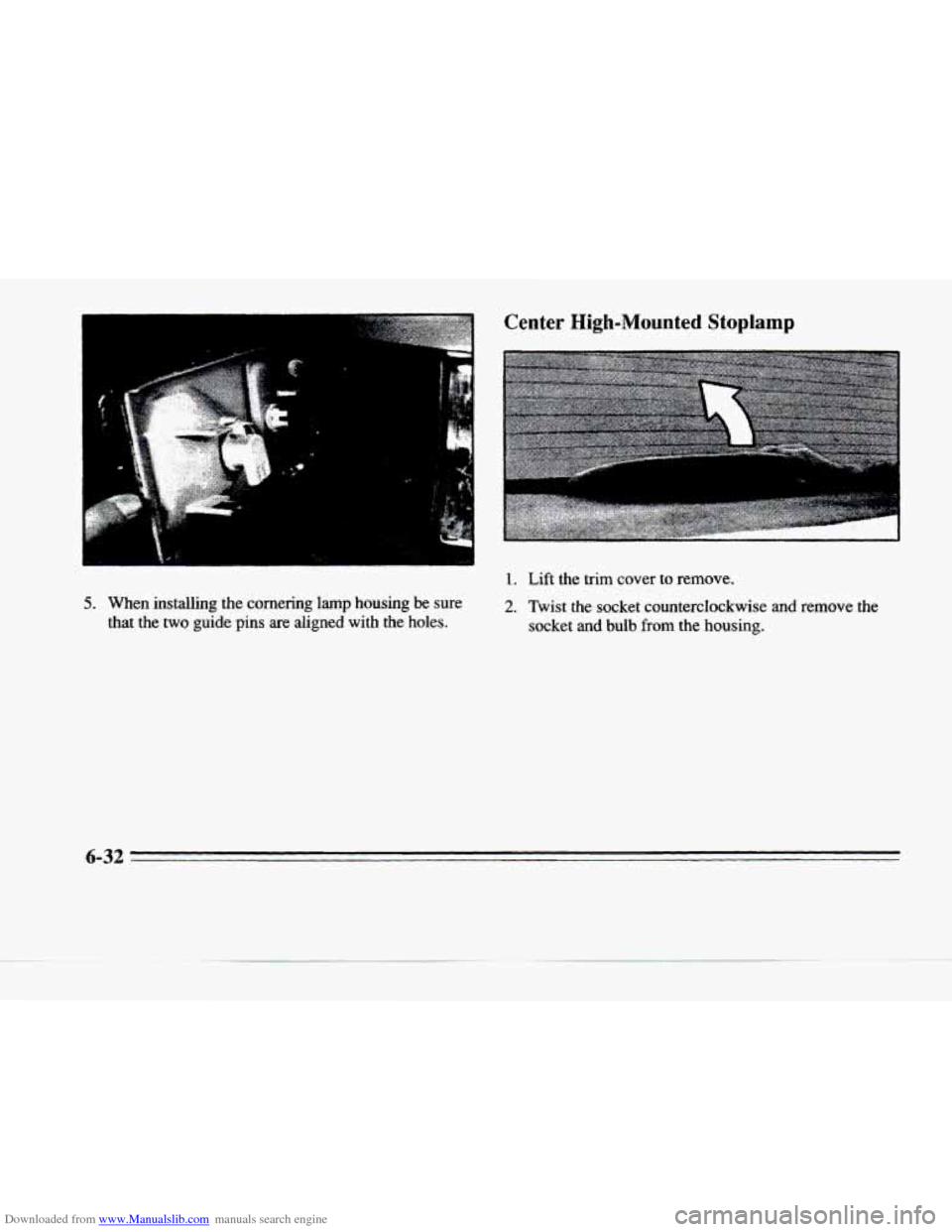
Downloaded from www.Manualslib.com manuals search engine Center High-Mounted Stoplamp
i
1
I,
5. When installing the cornering lamp housing be sure
that the two guide pins are aligned with the holes.
1. Lift the trim cover to remove.
2. Twist the socket counterclockwise and remove the
socket
and bulb from the housing.
6-32
Page 294 of 354
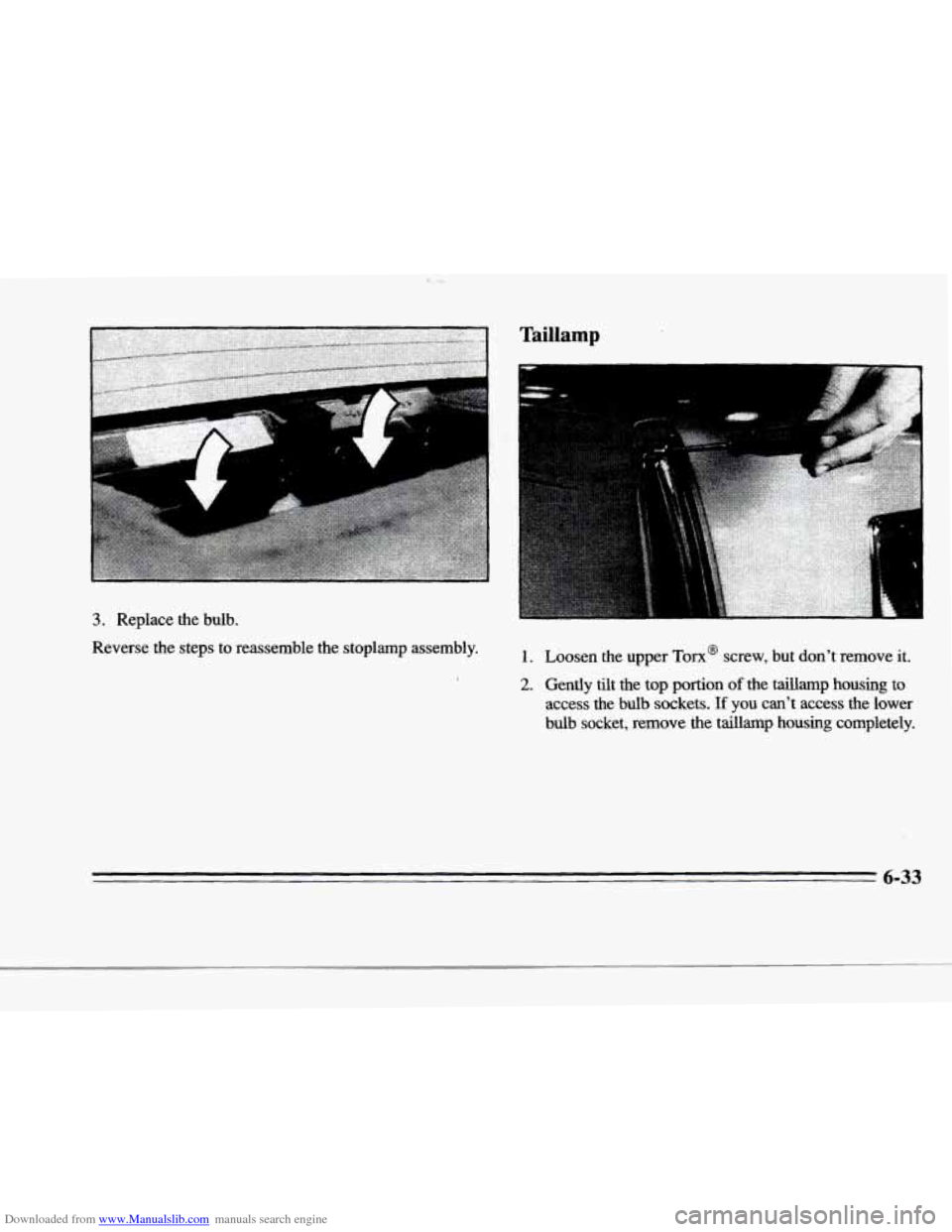
Downloaded from www.Manualslib.com manuals search engine r-
f-
3. Replace the bulb.
Reverse the steps to reassemble the stoplamp assembly.
Taillamp
1. Loosen the upper Tom@ screw, but don’t remove it.
2. Gently tilt the top portion of the taillamp housing to
access the bulb sockets.
If you can’t access the lower
bulb socket, remove the taillamp housing completely.
6-33
Page 295 of 354
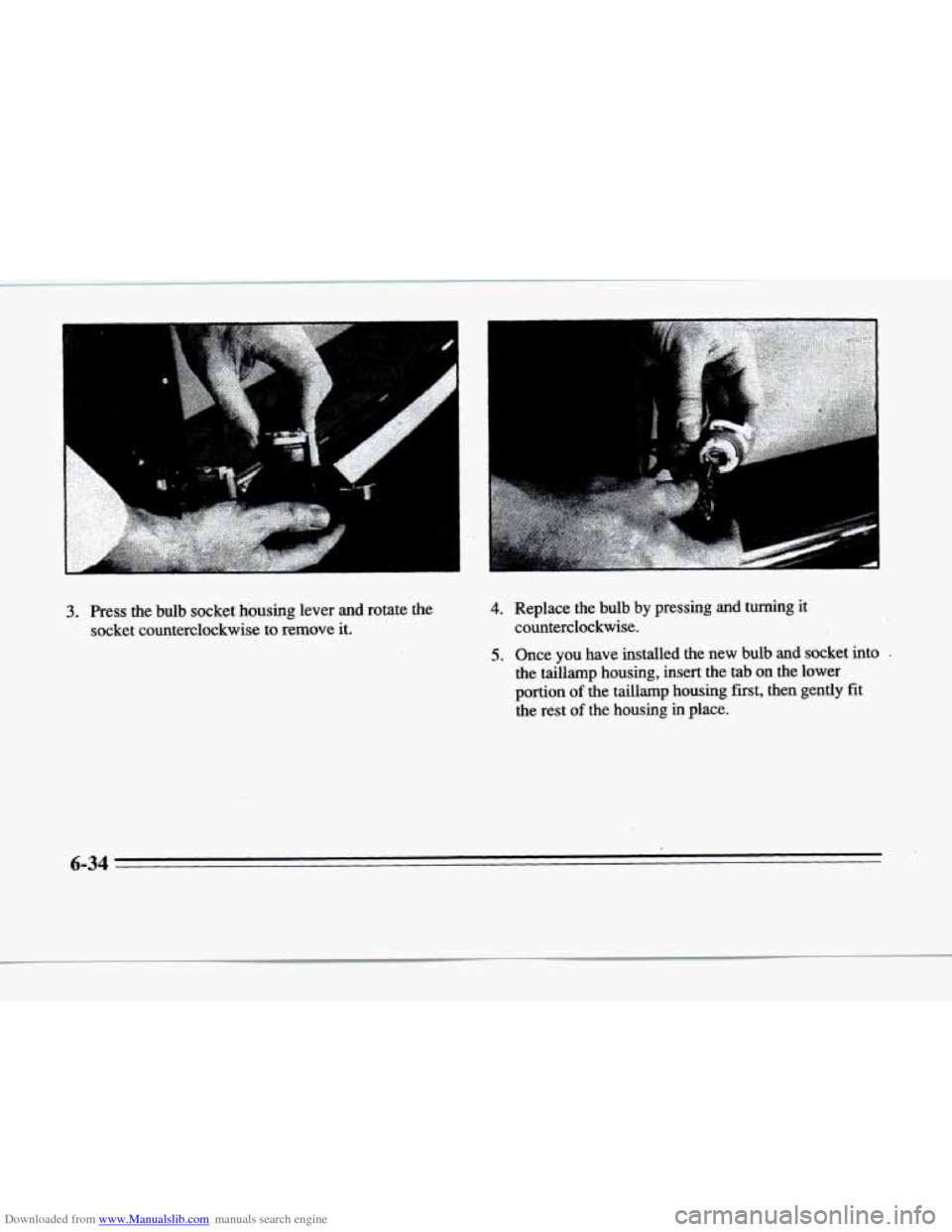
Downloaded from www.Manualslib.com manuals search engine c
L
3. Press the bulb socket' housing lever and rotate the
socket counterclockwise to remove it.
r
4. Replace the bulb by pressing and turning it
counterclockwise.
5. Once you have installed the new bulb and socket into .
the taillamp housing, insert the tab on the lower
portion
of the taillamp housing first, then gently fit
the rest
of the housing in place.
6-34
Page 296 of 354
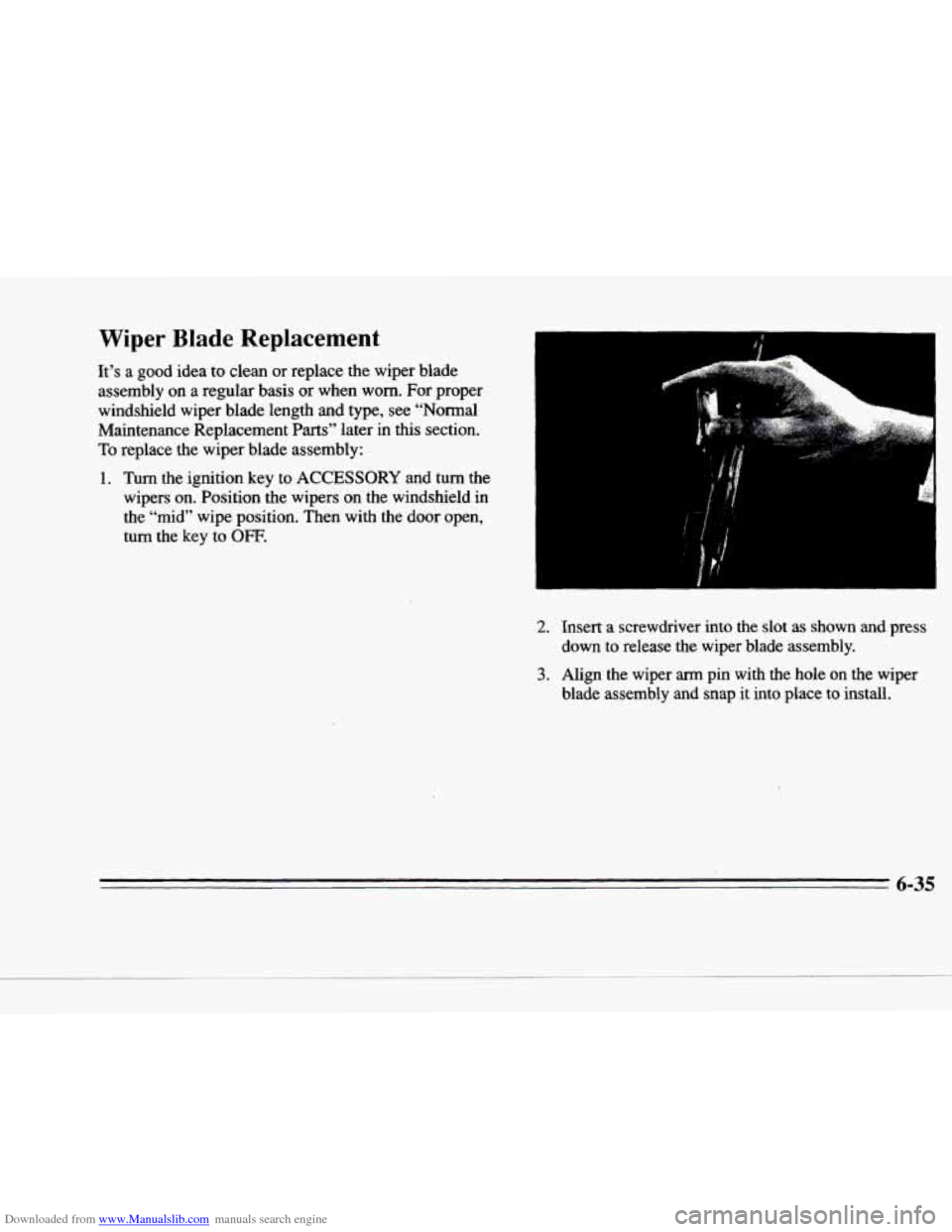
Downloaded from www.Manualslib.com manuals search engine 1c
i
Wiper Blade Replacement
It’s a good idea to clean or replace the wiper blade
assembly on a regular basis or when worn. For proper
windshield wiper blade length and type, see
“Normal
Maintenance Replacement Parts” later in this section.
To replace the wiper blade assembly:
1. Turn the ignition key to ACCESSORY and turn the
wipers on. Position the wipers on the windshield
in
the “mid” wipe position. Then with the door open,
turn the key to
OFF.
2. Insert a screwdriver into the slot as shown and press
down to release the wiper blade assembly.
3. Align the wiper arm pin with the hole on the wiper
blade assembly and snap it into place to install.
6-35
Page 297 of 354
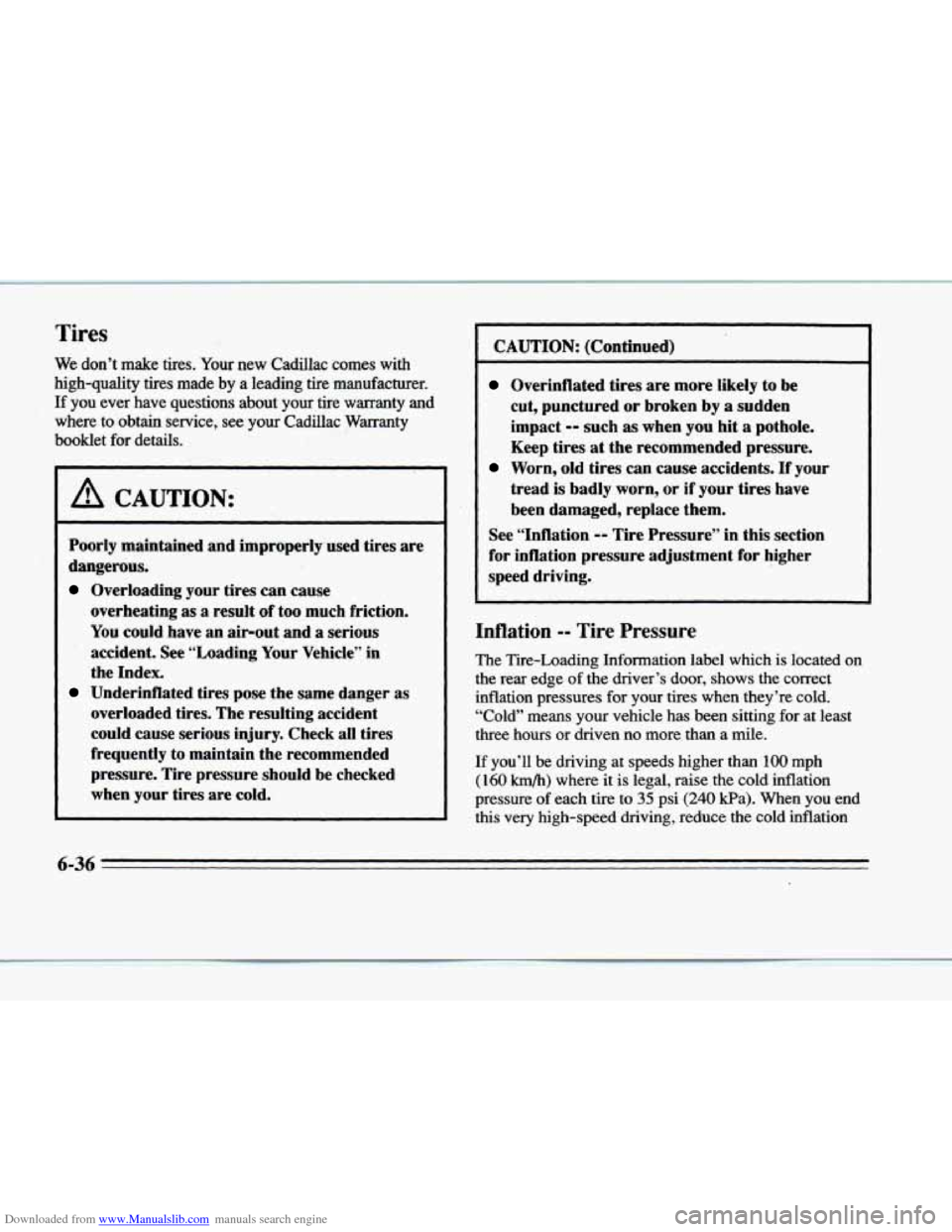
Downloaded from www.Manualslib.com manuals search engine Tires
We don’t make tires. Your new Cadillac comes with
high-quality tires made by a leading tire manufacturer.
If you ever have questions about your tire warranty and
where to obtain service, see your Cadillac Warranty
booklet for details.
A CAUTION:
Poorly maintained and improperly used tires are
dangerous.
Overloading your tires can cause
overheating
as a result of too much friction.
You could have an air-out and a serious
accident. See “Loading Your Vehicle’’ in
the Index.
Underinflated tires pose the same danger as
overloaded tires. The resulting accident
could cause serious injury. Check all tires
frequently to maintain
the recommended
pressure. Tire pressure should
be checked
when your tires are cold.
CAUTION: (Continued)
Overinflated tires are more likely to be
cut, punctured or broken by
a sudden
impact
-- such as when you hit a pothole.
Keep tires
at the recommended pressure.
Worn, old tires can cause accidents. If your
tread is badly worn, or if your tires have
been damaged, replace them.
See “Inflation
-- Tire Pressure’’ in this section
for inflation pressure adjustment for higher
speed driving.
Inflation -- Tire Pressure
The Tire-Loading Information label which is located on
the rear edge of the driver’s door, shows the correct
inflation pressures for your tires when they’re cold.
“Cold” means your vehicle has been sitting for at least
three hours or driven no more
than a mile.
If you’ll be driving at speeds higher than
100 mph
(160 km/h) where it is legal, raise the cold inflation
pressure
of each tire to 35 psi (240 Wa). When you end
this very high-speed driving, reduce the cold inflation
6-36
Page 298 of 354
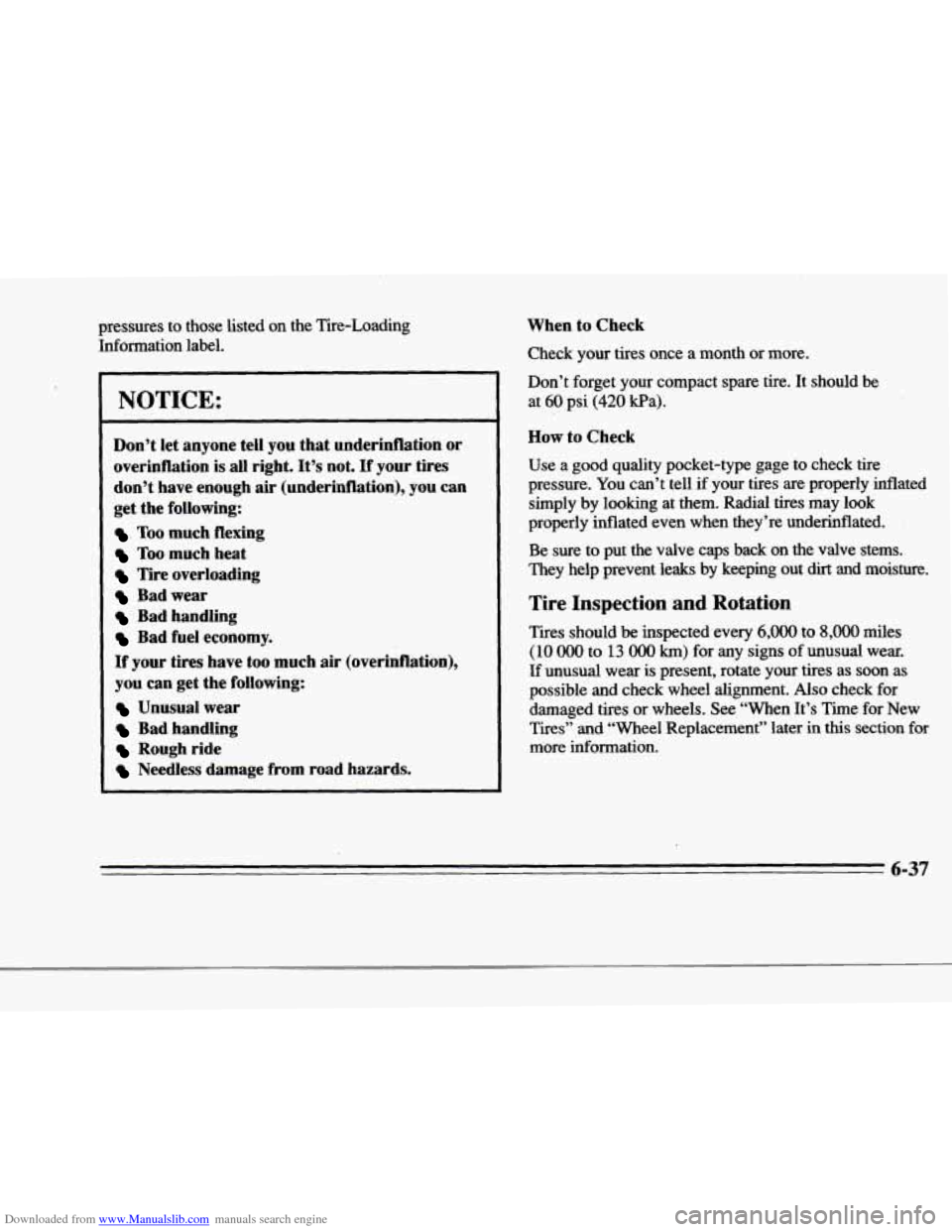
Downloaded from www.Manualslib.com manuals search engine f
f
r
I
r
r
r
?ressures to those listed on the Tire-Loading [nformation label.
NOTICE:
Don’t let anyone tell you that underinflation or
overinflation is all right. It’s not. If your tires
don’t have enough air (underinflation),
you can
get the following:
, Too much flexing
Too much heat
Tire overloading
Bad wear
Bad handling
Bad fuel economy.
If your tires have too much air (overinflation),
you can get the following:
Unusual wear
Bad handling
Needless damage from road hazards.
i Rough ride
When to Check
Check your tires once a month or more.
Don’t forget your compact spare tire. It should be
at
60 psi (420 Wa).
How to Check
Use a good quality pocket-type gage to check tire
pressure. You can’t tell
if your tires are properly inflated
simply by
looking at them. Radial tires may look
properly inflated even when they’re underinflated.
Be sure to put the valve caps back on the valve stems.
They help prevent leaks by keeping out dirt and moisture.
Tire Inspection and Rotation
Tires should be inspected every 6,000 to 8,000 miles
(10 OOO to 13 000 km) for any signs of unusual wear.
If unusual wear is present, rotate your tires as soon
as
possible and check wheel alignment. Also check for
damaged tires
or wheels. See “When It’s Time for New
Tires” and “Wheel Replacement” later
in this section for
more information.
6-37
Page 299 of 354
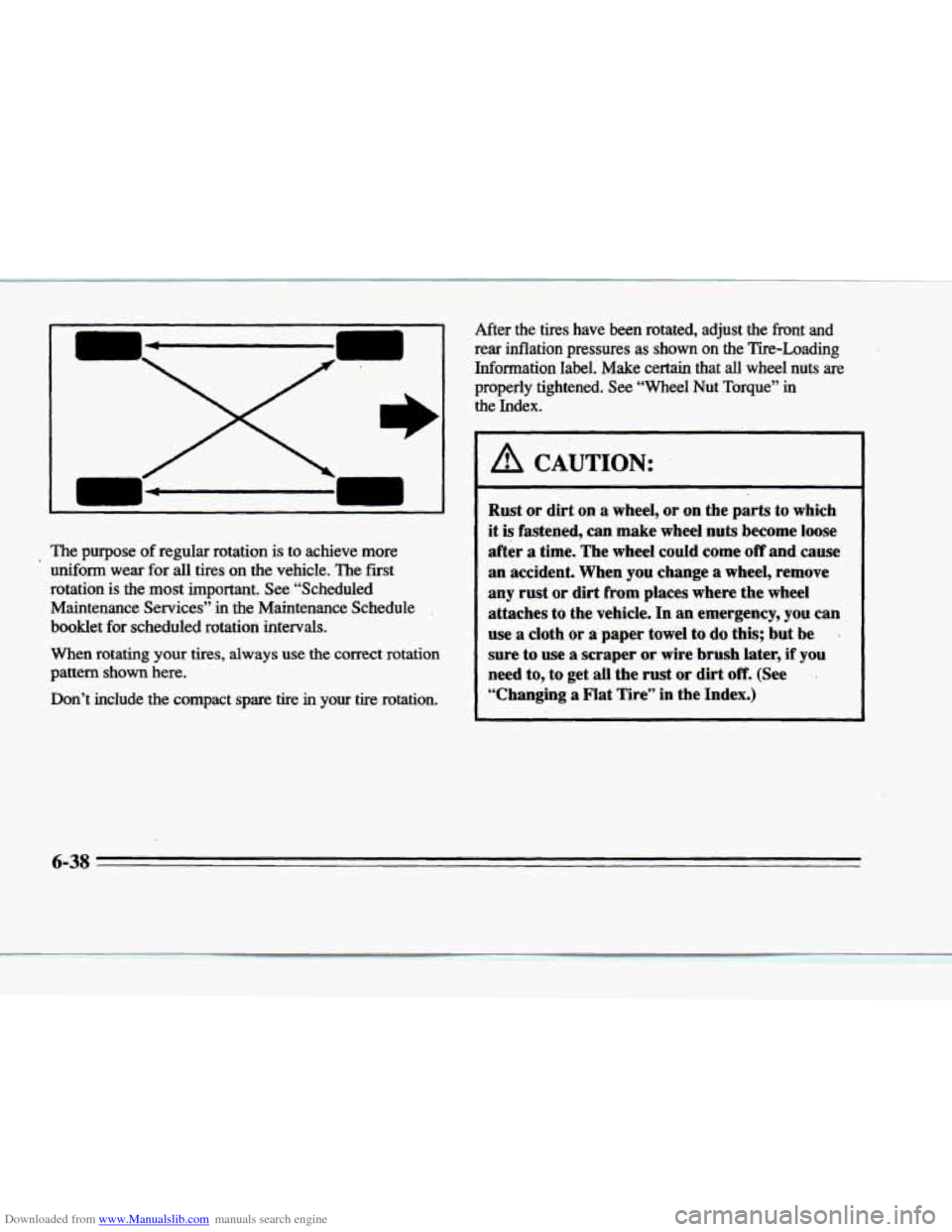
Downloaded from www.Manualslib.com manuals search engine I I
I I
The purpose of regular rotation is to achieve more
uniform wear
for all tires on the vehicle. The first
rotation is the most important. See “Scheduled
Maintenance Services”
in the Maintenance Schedule
booklet for scheduled rotation intervals.
When rotating
your tires, always use the correct rotation
pattern
shown here.
Don’t include the compact spare
tire in your tire rotation. After
the tires have been rotated, adjust the front and
rear inflation pressures as shown on the Tire-Loading
Information label. Make certain that all wheel nuts are
properly tightened. See “Wheel
Nut Torque” in
the Index.
A CAUTION:
Rust or dirt on a wheel, or on the parts to which
it is fastened,
can make wheel nuts become loose
after
a time. The wheel could come off and cause
an accident. When
you change a wheel, remove
any rust
or dirt from places where the wheel
attaches to the vehicle. In an emergency,
you can
use a cloth or a paper towel to do this; but be I
sure to use a scraper or wire brush later, if you
need to, to get
all the rust or dirt off. (See I
“Changing a Flat Tire” in the Index.)
I
.. .
6-38
Page 300 of 354
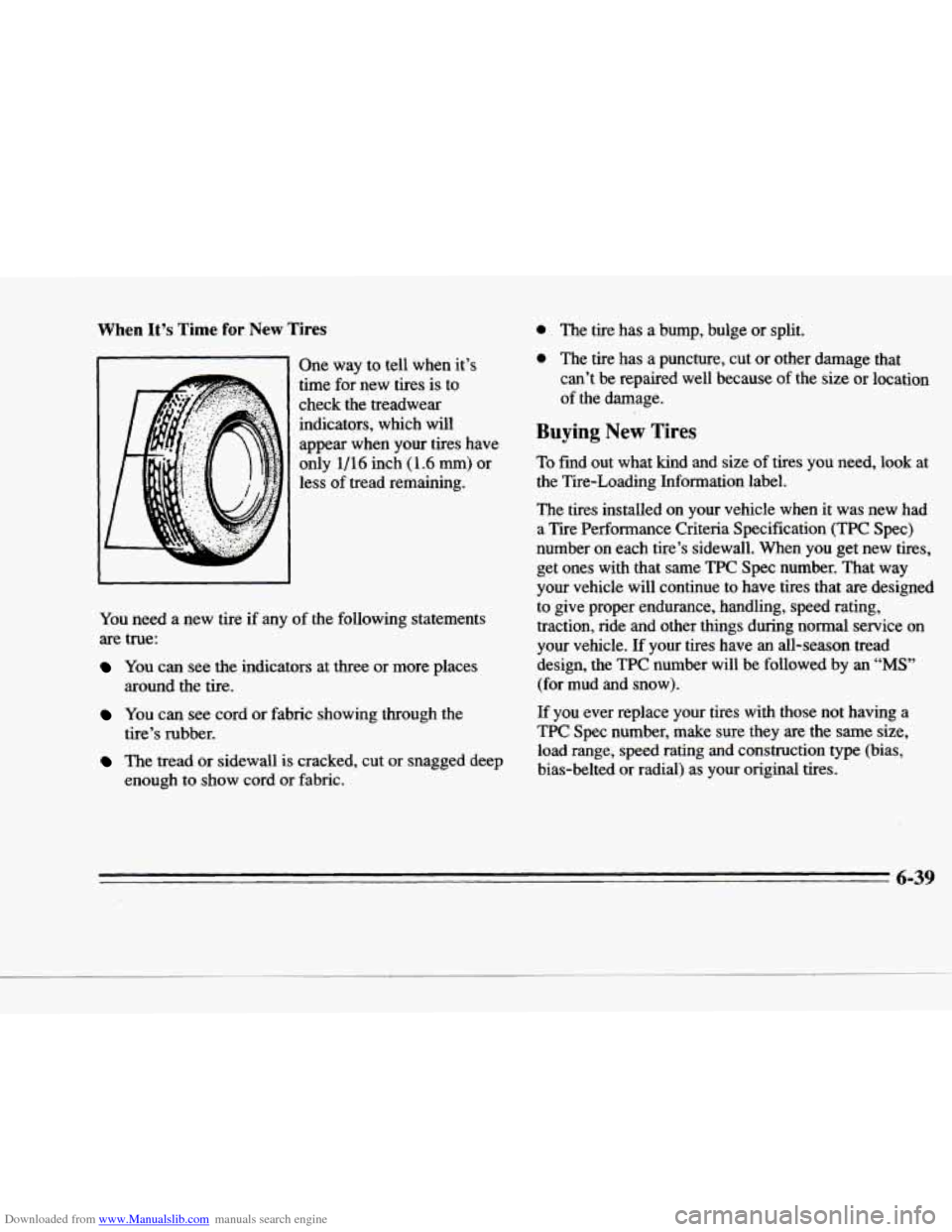
Downloaded from www.Manualslib.com manuals search engine c
When It’s Time for New Tires
One way to tell when it’s
1 A time for-new tires is to
check the treadwear indicators,
which will
appear when
your tires have
only 1/16 inch (1.6 mm) or
less
of tread remaining.
+- You need a new tire if any of the following statements
are true:
c
You can see the indicators at three or more places
around the tire.
You can see cord or fabric showing through the
The tread or sidewall is cracked, cut or snagged deep
tire’s rubber.
enough
to show cord or fabric.
0 The tire has a bump, bulge
or split.
0 The tire has a puncture, cut or other damage that
can’t be repaired
well because of the size or location
of the damage.
Buying New Tires
To find out what kind and size of tires you need, look at
the Tire-Loading Information label.
The tires installed on your vehicle when it was new had a Tire Performance Criteria Specification
(TPC Spec)
number on each tire’s sidewall. When you get new tires, get ones with that same
TPC Spec number. That way
your vehicle will continue to have tires that are designed
to give proper endurance, handling, speed rating,
traction, ride and other things during normal service on your vehicle.
If your tires have an all-season tread
design, the TPC number will be followed
by an “MS”
(for mud and snow).
If you ever replace your tires with those not having a
TPC Spec number, make sure they are the same size,
load range, speed rating and construction type (bias,
bias-belted or radial) as your original tires.
6-39